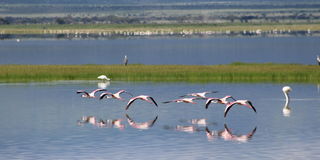Why the flamingos are moving to Amboseli

Happy Lesser flamingos in Amboseli National Park. Photo | Denis Bouillon.
What you need to know:
- A year ago, we saw not a single flamingo in Amboseli
- Then suddenly the gregarious bird on a night flight ‘discovered’ the new water bodies in Amboseli
It’s a new dawn with climate change and Amboseli’s got a fresh look with flamingos everywhere under the gaze of Kilimanjaro’s snow-capped peak. The ubiquitous dust pans and spiralling dust devils are absent. Instead it’s lush and green with water shimmering in the distance. Amboseli – derived from the Maa word ‘empusel’ for ‘salty dusty place’ – looks very different with the phenomenal rains.
It’s an awesome entry into Amboseli from the private route on its eastern flanks from the Maasai-owned Selenkay Conservancy.
A year ago, we saw not a single flamingo in Amboseli. Then suddenly the gregarious bird on a night flight ‘discovered’ the new water bodies in Amboseli. The birds normally migrate at night and water even on the darkest of nights. The flaming pink birds swooped down to take up residence.
Associated with the lakes of the Great Rift Valley, these super-specialised birds have different lakes for different purposes.
They feed on the alkaline lakes of Turkana, Longipi, Bogoria, Nakuru, Elmenteita, Magadi and Natron in Tanzania. They only lay their eggs at Natron because it has all the right conditions to qualify as a flamingo nursery. Baringo and Naivasha including the fresh river inflows in the saline lakes is where they drink fresh water. If they were to drink the salt water, the poor birds would be dead. They feed with their heads turned upside-down and squirt out the salt water with their piston-like tongues.
But now things are different in the Rift Valley lakes.

Leeser flamingos in Amboseli National Park. Copyright Denis Bouillon. One time use onky for Rupi Mangat Photo | Pool
“The Rift Valley lakes have more water and become less alkaline,” explains Fleur Ng’weno, Kenya’s legendary birder. “The cyanobacteria that the flamingos feed on does not grow well in fresh water. So the flamingos are short of food and looking for suitable lakes and food everywhere.”
Hence, they find the prehistoric lakes of Amboseli.
A Coloured World
Grey elephants fill the lush swamps, swooping up reeds with their trunks and sucking in bales of water. The colour-chart is filled with green, pink, grey, white clouds, blue skies and clear water reflecting the myriad of water birds that include the dainty lily trotters, Great white Pelicans, ducks and geese and flitting from the shrubs, the magnificent jewelled Malachite king fishers. We spot two pairs of the critically endangered Grey crowned cranes, each with a pair of chicks, a good sign that Amboseli’s swamps, forests and grassland are healthy for these cranes to lay eggs, roost and forage in each habitat respectively.
"With another year of excellent rainfall Amboseli is looking as lush and beautiful as I've ever seen it in all my years here,” quips Dr Cynthia Moss who still carries on with research on elephants of Amboseli which she began in 1972 and founded Amboseli Trust for Elephants.
“The wildlife is flourishing,” she continues. “The elephants continue to do very well under these conditions combined with good protection from KWS and community scouts. Last year saw the birth of 236 elephant calves, a new record, and among those there were two sets of twins. Right now several of the biggest males are in the Park searching for receptive females."
Up on the prehistoric Observation Hill facing Kilimanjaro, the elephants look like dots. The water is so blue that the pelicans look whiter than usual.

Grey crowned crane with her chicks in Amboseli National Park. Copyright Denis Bouillon. One time use onky for Rupi Mangat Photo | Pool
Driving through the lush grass-clad plains, a jet-black serval makes a momentary appearance only to vanish again. We miss it except for Amos, our Maasai guide from Selenkay.
A melanistic serval is a rare sighting, its genes carrying a mutation that creates more dark pigment than light pigment. So we wait, hoping to get a perfect photo shoot. But no such luck.
A little smaller than the cheetah, a serval’s normal coat is spotted with black stripes running on along the spine. It has the longest legs of any cat relative to its body size. Today, the serval is only found in Africa – and mostly in the grasslands of sub-Saharan Africa – and in protected areas.
Awed in Amboseli
Check out Porini Amboseli Camp in Selenkay Conservancy, 186 kms east of Nairobi, easy to reach on the new tarmac road from Kajiado. Selenkay Conservancy is a vital dispersal area for the elephants of Amboseli.
You can drive there but private cars are not allowed for game drives in the conservancy.
You can also stay inside the park with several gates to enter through. Carry your ID for citizen/resident rates.
Log onto Amboseli Trust for Elephants for updates on these mega-herbivores.




